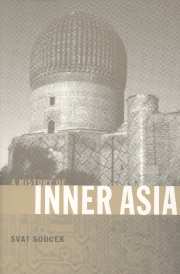Book contents
- Frontmatter
- Contents
- List of maps
- Preface
- Introduction
- 1 The beginnings
- 2 The Kök Turks, the Chinese expansion, and the Arab conquest
- 3 The Samanids
- 4 The Uighur kingdom of Qocho
- 5 The Qarakhanids
- 6 Seljukids and Ghaznavids
- 7 The conquering Mongols
- 8 The Chaghatayids
- 9 Timur and the Timurids
- 10 The last Timurids and the first Uzbeks
- 11 The Shaybanids
- 12 The rise of Russia, the fall of the Golden Horde, and the resilient Chaghatayids
- 13 The Buddhist Mongols
- 14 Bukhara, Khiva, and Khoqand in the seventeenth to nineteenth centuries
- 15 The Russian conquest and rule of Central Asia
- 16 From Governorates-General to Union Republics
- 17 Soviet Central Asia
- 18 Central Asia becomes independent
- 19 Sinkiang as part of China
- 20 Independent Central Asian Republics
- 21 The Republic of Mongolia
- Summary and conclusion
- Appendix 1 Dynastic tables
- Appendix 2 Country data
- Select bibliography
- Index
2 - The Kök Turks, the Chinese expansion, and the Arab conquest
Published online by Cambridge University Press: 05 June 2012
- Frontmatter
- Contents
- List of maps
- Preface
- Introduction
- 1 The beginnings
- 2 The Kök Turks, the Chinese expansion, and the Arab conquest
- 3 The Samanids
- 4 The Uighur kingdom of Qocho
- 5 The Qarakhanids
- 6 Seljukids and Ghaznavids
- 7 The conquering Mongols
- 8 The Chaghatayids
- 9 Timur and the Timurids
- 10 The last Timurids and the first Uzbeks
- 11 The Shaybanids
- 12 The rise of Russia, the fall of the Golden Horde, and the resilient Chaghatayids
- 13 The Buddhist Mongols
- 14 Bukhara, Khiva, and Khoqand in the seventeenth to nineteenth centuries
- 15 The Russian conquest and rule of Central Asia
- 16 From Governorates-General to Union Republics
- 17 Soviet Central Asia
- 18 Central Asia becomes independent
- 19 Sinkiang as part of China
- 20 Independent Central Asian Republics
- 21 The Republic of Mongolia
- Summary and conclusion
- Appendix 1 Dynastic tables
- Appendix 2 Country data
- Select bibliography
- Index
Summary
In 622, as we have said, the steppe empire of the Kök Turks stretched from Mongolia to Kyrgyzstan and Kazakhstan, with the valleys of the Orkhon and Chu representing the cores of its eastern and western wings. At both ends the Turks had lively relations with great sedentary empires and civilizations to the south. In the east, China was the immediate neighbor; in the west, Sasanian Iran.
There was one significant diference, however: the buffer zone represented by Transoxania. Its Sogdian princes recognized the suzerainty of the Turkic qaghans ever since their earlier overlords, the Hephtalite kings of Afghanistan, were defeated by a Turko-Persian coalition in the first half of the 560s. Khurasan, also a Hephtalite possession, fell to Iran, and the two empires were thus separated only by the Amu Darya. The sedentary Sogdian inhabitants of Transoxania endeavored to foster peaceful, especially mercantile contacts with all their neighbors, and were content to recognize, as we have said, the suzerainty of the Turkic qaghans. Above all, the Persians made only rare and unsuccessful attempts to penetrate Transoxania, and never the home ground of the Turks in the steppes, in contrast to Chinese diplomacy and military campaigns. A dramatic illustration of the latter is provided by the attacks mounted by the Tang emperor Tai-tsung (600–49; ruled from 627) in 630, and by the reduction, over the next fifty years, of the Kök Turkic empire's eastern wing to the position of a Chinese vassal.
- Type
- Chapter
- Information
- A History of Inner Asia , pp. 51 - 69Publisher: Cambridge University PressPrint publication year: 2000



